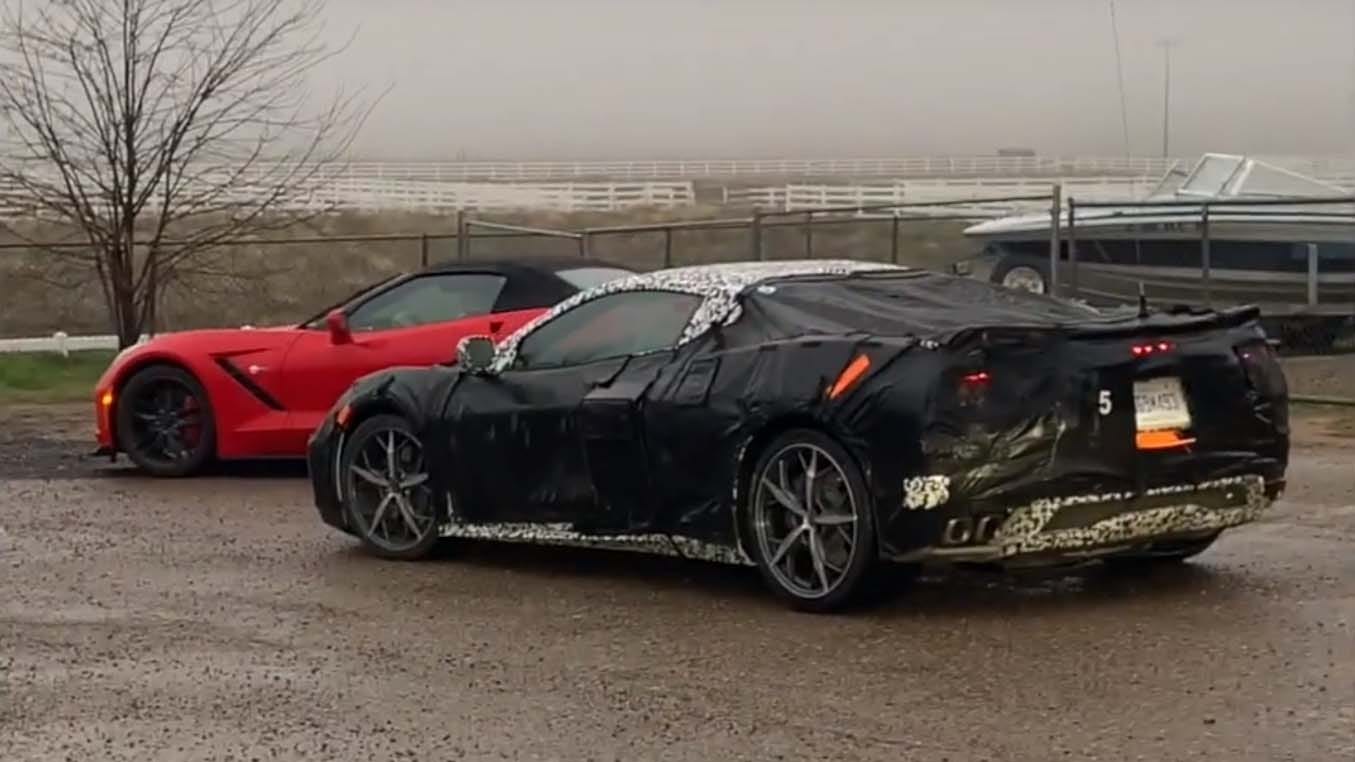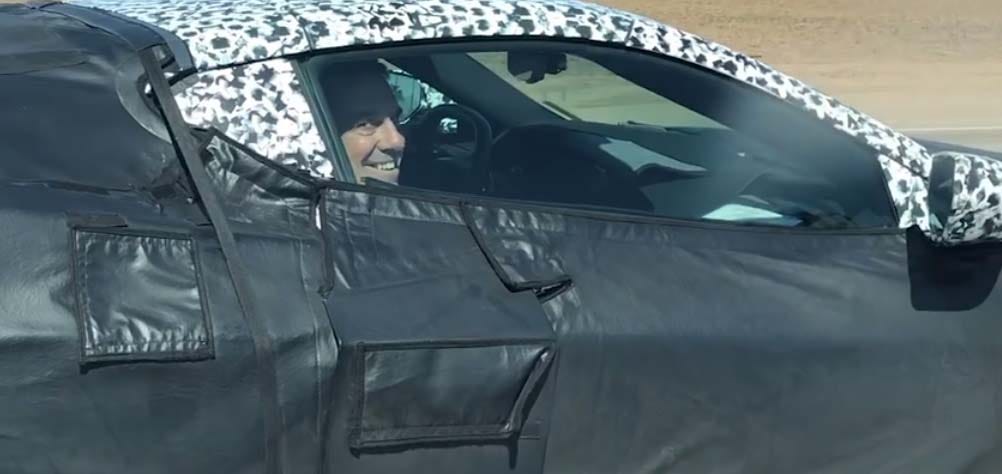Elusive Chevy Corvette C8 starts to come into the open
 Henry Payne
Henry Payne
The mid-engine Chevy Corvette C8 is the auto industry’s Bigfoot: lots of sightings in the wild, but no confirmation as to when it will be officially revealed.
The 2019 Detroit auto show? Came and went. A springtime reveal at an exotic location? Not looking likely.
But we know the elusive Corvette exists because, well, we just saw video of General Motors President Mark Reuss riding in a caravan of camouflaged C8s in Arizona. And because a group of journalists stumbled across five similar C8s north of San Diego. And then there was the barely disguised mid-engine Corvette that broke down last week at a Speedway gas station near GM's Milford Proving Grounds and had to be towed.
It's driving would-be Corvette buyers to distraction.

"It's a great-looking car, and everybody's eagerly waiting to be the first to own one on the block. But information about it is just diddling out, and it's making us all crazy," says Mike Figueroa of Galena, Illinois, a former Corvette owner.
Figueroa, and many more like him, want to buy the next-generation Corvette — if they just knew when it will arrive.
General Motors won’t comment and officially doesn't acknowledge that the car even exists. "We do not comment on future product," Chevrolet spokesman Kevin Kelly said.
But here’s what we know and what's being reported.

Originally targeted for a coming-out-party at the Detroit show in January, the C8 was reportedly delayed until late spring — and now later in the year, according to several industry sources. The chief culprit? Electrical gremlins, they say.
Observers have speculated that the Corvette C8's debut could be coordinated with the 25th anniversary of the National Corvette Museum in Bowling Green, Kentucky, in late August. The Corvette assembly plant in Bowling Green has undergone an overhaul in the last three years, including a massive paint-plant investment, to prepare for the mid-engine car.
A debut of the C8 in late August would also allow Chevy to showcase the car at Corvettes at Carlisle, a huge annual gathering of Corvette owners in Carlisle, Pennsylvania, in late August.
Whatever the venue, the intense speculation speaks to how important this eighth-generation Corvette is to GM — and to the external pressures building on Chevy to produce the car.
Sales of C7 Corvettes have fallen dramatically this year — off 20 percent from a year ago — as buyers anticipate the mid-engine supercar. About 10,000 C7s reportedly languish unsold on dealer lots, sitting for an average of 232 days, unprecedented for the iconic sports car. Potential buyers like Figueroa say dealers are bending over backward to offer deals, which get sweeter the longer the C8 is delayed.
The good news for Chevy is the C7's stale sales indicate huge pent-up demand for the C8.
The clock is also ticking on Corvette's race program, which is expected to debut the car for the 2020 IMSA Weathertech racing season at next January's Rolex 24 Hours of Daytona. The current front-engine race car is getting long in the tooth against formidable competition like the mid-engine Ford GT. The race-car version of the C8 has been seen testing at tracks in Florida, Wisconsin and Germany.
While endurance-racing rules are famously opaque when it comes to official recognition of production cars, the Corvette race car effectively has to be licensed for competition by the end of 2019 in order to qualify for Daytona and LeMans next year. GM has traditionally introduced its production car before racing it. The front-engine C7, for example, went into production in September 2013 ahead of the C7-R's 2014 Daytona debut.
The multitude of sightings of camouflaged cars — from Reuss' ride in Arizona, to California, Colorado and Florida — suggest a mature exterior design ready for prime time.
The idea of a mid-engine Corvette actually dates back to legendary designer Zora Arkus-Duntov, who considered the layout in the early 1960s. But the program really picked up speed in 2007 when it was green-lighted by GM, only to be shelved by the Great Recession. Post-recession, it was full speed ahead.

But for all its groundwork, the C8 has been a development headache.
"The mid-engine car is the most protracted Corvette ever," says ex-Car and Driver writer Don Sherman of Hagerty, the automotive publication. Sherman has made a career out of chasing the elusive 'Vette.
Sherman speculates the C8's growing pains have their roots in the car's revolutionary nature: It is not just the first mid-engine Corvette, the C8 is a clean-sheet program.
"Shuffling the engine location isn't that big a deal," says Sherman. "But the Corvette team is using the C8 to re-invent the entire car."
While Sherman's latest reporting at Hagerty indicates some chassis-twisting issues with the high-horsepower mill, a multitude of sources indicate the biggest source of the C8's delays involve the electrical system. The issue seems to be GM's effort to move to a new, common electrical-architecture using a so-called CAN (computer area network). The Corvette has proved difficult to adapt.
Despite its exotic nature, Chevy is still expected to fall back on some familiar tools to keep the base car's costs in line — a signature attribute of Corvette that has gained it a reputation as "the affordable supercar." The standard engine is reportedly a good old push-rod 6.2-liter V-8 code-named the LT2, putting the power to wheels through a dual-clutch automatic transmission. The current LT1-base engine's horsepower is expected to be pushed past the current 460 horses.
So endowed, industry observers expect the C8 to cost $4,000-$5,000 more than the current front-engine model. That would put its starting price in the neighborhood of $60,000 — still well below, say, a $92,000 Porsche 911.
The mid-engine beast may disappoint manual-gearbox customers, but it will still satisfy Corvette traditionalists by fitting two golf bags in the front truck, or "frunk."
Unless, of course, you get the rumored hybrid model with an electric motor crowding out frunk space. Seems 1,000 horsepower comes with its sacrifices.
Henry Payne is auto critic for The Detroit News. Find him at hpayne@detroitnews.com or Twitter @HenryEPayne. Catch “Car Radio with Henry Payne” from noon-2 p.m. Saturdays on 910 AM Superstation.